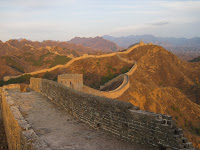 So we were ready bright and early for our guide Tommy to pick us up. It was a rainy morning, but we were hopeful it would clear up as the day went on, and as we left the smog of Beijing maybe the sun would shine. Part of the tour was also the Sacred Way, Ming Tombs and a visit to the Olympic site.
So we were ready bright and early for our guide Tommy to pick us up. It was a rainy morning, but we were hopeful it would clear up as the day went on, and as we left the smog of Beijing maybe the sun would shine. Part of the tour was also the Sacred Way, Ming Tombs and a visit to the Olympic site. We started out with the Olympic site, which was only of mild interest to Scott and I. We took a few pictures in the rain and headed out of town for the Sacred Way.
We started out with the Olympic site, which was only of mild interest to Scott and I. We took a few pictures in the rain and headed out of town for the Sacred Way.The Sacred Way is the path that leads to the Ming Tombs, where the Emporer would start their journey to the tombs when they died. Constructed in 1540, during the Ming Dynasty, the Sacred

 way is a road lined with lifesize stone statues. These statues are 12 human figures (including the general, civil officials and meritorious officials) and 24 animals which are lion, camel, elephant, xiezhi (a mythological unicorn), qilin (one of the four "divine animals, the other three are dragon, phoenix and tortoise), and horse. There are 4 of each of these animals: two standing and two squatting with different meanings. Lion symbolizes awesome solemnity because of their ferocity. Camel and elephant are meant to suggest the vastness of the territory controlled by the court, because they are dependable transport in desert and tropics. Xiezhi was put there to keep evil spirits away, because it was believed to possess the sixth sense to tell right and wrong. If two men fight, a xiezhi would gore the wicked one. Qilin, an auspicious symbol, was placed on two sides. Horse, as the emperor's mount, is absolutely indispensable. It is said that these animals are supposed to change guard at midnight.
way is a road lined with lifesize stone statues. These statues are 12 human figures (including the general, civil officials and meritorious officials) and 24 animals which are lion, camel, elephant, xiezhi (a mythological unicorn), qilin (one of the four "divine animals, the other three are dragon, phoenix and tortoise), and horse. There are 4 of each of these animals: two standing and two squatting with different meanings. Lion symbolizes awesome solemnity because of their ferocity. Camel and elephant are meant to suggest the vastness of the territory controlled by the court, because they are dependable transport in desert and tropics. Xiezhi was put there to keep evil spirits away, because it was believed to possess the sixth sense to tell right and wrong. If two men fight, a xiezhi would gore the wicked one. Qilin, an auspicious symbol, was placed on two sides. Horse, as the emperor's mount, is absolutely indispensable. It is said that these animals are supposed to change guard at midnight. After being in Beijing, a city of 17 million people, chaos on the roads, noise, the Sacred Way was tranquil.
After being in Beijing, a city of 17 million people, chaos on the roads, noise, the Sacred Way was tranquil.And that is where my journey to the Great Wall began and ended. During the morning I could feel the start of a bladder infection brewing, and I spent a few hours telling myself I would be ok because we are only gone overnight and I could get medicine the next day. By lunch I knew that wasn't possible. It was agony trying to make the decision of what to do next, but I think we made the right decision. Scott decided to go on, and the tour company was wonderful, they called another drive to come and get me and drive me back to the hotel. We knew the English speaking staff at the hotel would be able to help me. They sent me to the English speaking hospital in Beijing, another terrifying cab ride to the other side of the city. I met with a Canadian doctor and $150 later had the antibiotics I needed. Thankful I had a safe, warm place to recover while Scott was away I headed back to the hotel. Such a disappointment, things don't always turn out the way you planned when you travel.
Anne













 Yu-Chhan is seen in this picture closest to the stone on the left side. From left to right you see Anne, Scott, Sidney, Yu-Chhan, Carys Humphries, Doreen Thomas & Haydn Thomas (Wales).
Yu-Chhan is seen in this picture closest to the stone on the left side. From left to right you see Anne, Scott, Sidney, Yu-Chhan, Carys Humphries, Doreen Thomas & Haydn Thomas (Wales).



























